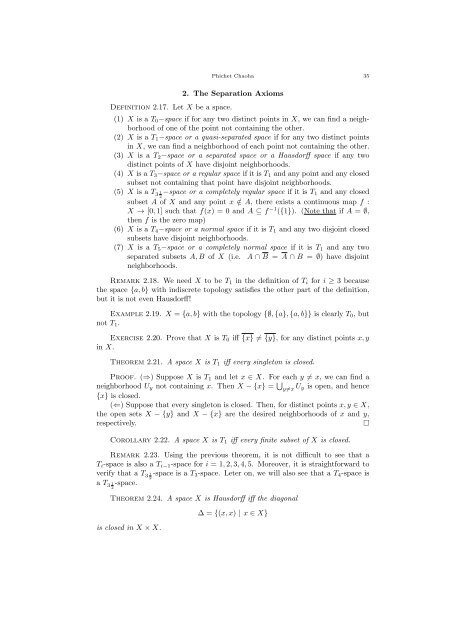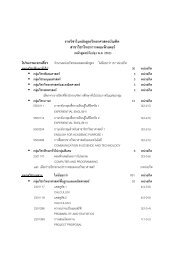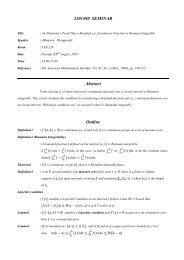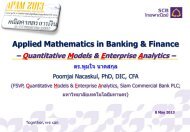Lecture Notes Topology (2301631) Phichet Chaoha Department of ...
Lecture Notes Topology (2301631) Phichet Chaoha Department of ...
Lecture Notes Topology (2301631) Phichet Chaoha Department of ...
Create successful ePaper yourself
Turn your PDF publications into a flip-book with our unique Google optimized e-Paper software.
<strong>Phichet</strong> <strong>Chaoha</strong> 35<br />
Definition 2.17. Let X be a space.<br />
2. The Separation Axioms<br />
(1) X is a T 0 −space if for any two distinct points in X, we can find a neighborhood<br />
<strong>of</strong> one <strong>of</strong> the point not containing the other.<br />
(2) X is a T 1 −space or a quasi-separated space if for any two distinct points<br />
in X, we can find a neighborhood <strong>of</strong> each point not containing the other.<br />
(3) X is a T 2 −space or a separated space or a Hausdorff space if any two<br />
distinct points <strong>of</strong> X have disjoint neighborhoods.<br />
(4) X is a T 3 −space or a regular space if it is T 1 and any point and any closed<br />
subset not containing that point have disjoint neighborhoods.<br />
(5) X is a T 3 1 −space or a completely regular space if it is T 1 and any closed<br />
2<br />
subset A <strong>of</strong> X and any point x /∈ A, there exists a continuous map f :<br />
X → [0, 1] such that f(x) = 0 and A ⊆ f −1 ({1}). (Note that if A = ∅,<br />
then f is the zero map)<br />
(6) X is a T 4 −space or a normal space if it is T 1 and any two disjoint closed<br />
subsets have disjoint neighborhoods.<br />
(7) X is a T 5 −space or a completely normal space if it is T 1 and any two<br />
separated subsets A, B <strong>of</strong> X (i.e. A ∩ B = A ∩ B = ∅) have disjoint<br />
neighborhoods.<br />
Remark 2.18. We need X to be T 1 in the definition <strong>of</strong> T i for i ≥ 3 because<br />
the space {a, b} with indiscrete topology satisfies the other part <strong>of</strong> the definition,<br />
but it is not even Hausdorff!<br />
Example 2.19. X = {a, b} with the topology {∅, {a}, {a, b}} is clearly T 0 , but<br />
not T 1 .<br />
Exercise 2.20. Prove that X is T 0 iff {x} ̸= {y}, for any distinct points x, y<br />
in X.<br />
Theorem 2.21. A space X is T 1 iff every singleton is closed.<br />
Pro<strong>of</strong>. (⇒) Suppose X is T 1 and let x ∈ X. For each y ≠ x, we can find a<br />
neighborhood U y not containing x. Then X − {x} = ∪ y≠x U y is open, and hence<br />
{x} is closed.<br />
(⇐) Suppose that every singleton is closed. Then, for distinct points x, y ∈ X,<br />
the open sets X − {y} and X − {x} are the desired neighborhoods <strong>of</strong> x and y,<br />
respectively.<br />
□<br />
Corollary 2.22. A space X is T 1 iff every finite subset <strong>of</strong> X is closed.<br />
Remark 2.23. Using the previous theorem, it is not difficult to see that a<br />
T i -space is also a T i−1 -space for i = 1, 2, 3, 4, 5. Moreover, it is straightforward to<br />
verify that a T 3 1 -space is a T 3-space. Leter on, we will also see that a T<br />
2 4 -space is<br />
a T 3 1 -space.<br />
2<br />
Theorem 2.24. A space X is Hausdorff iff the diagonal<br />
is closed in X × X.<br />
∆ = {(x, x) | x ∈ X}





